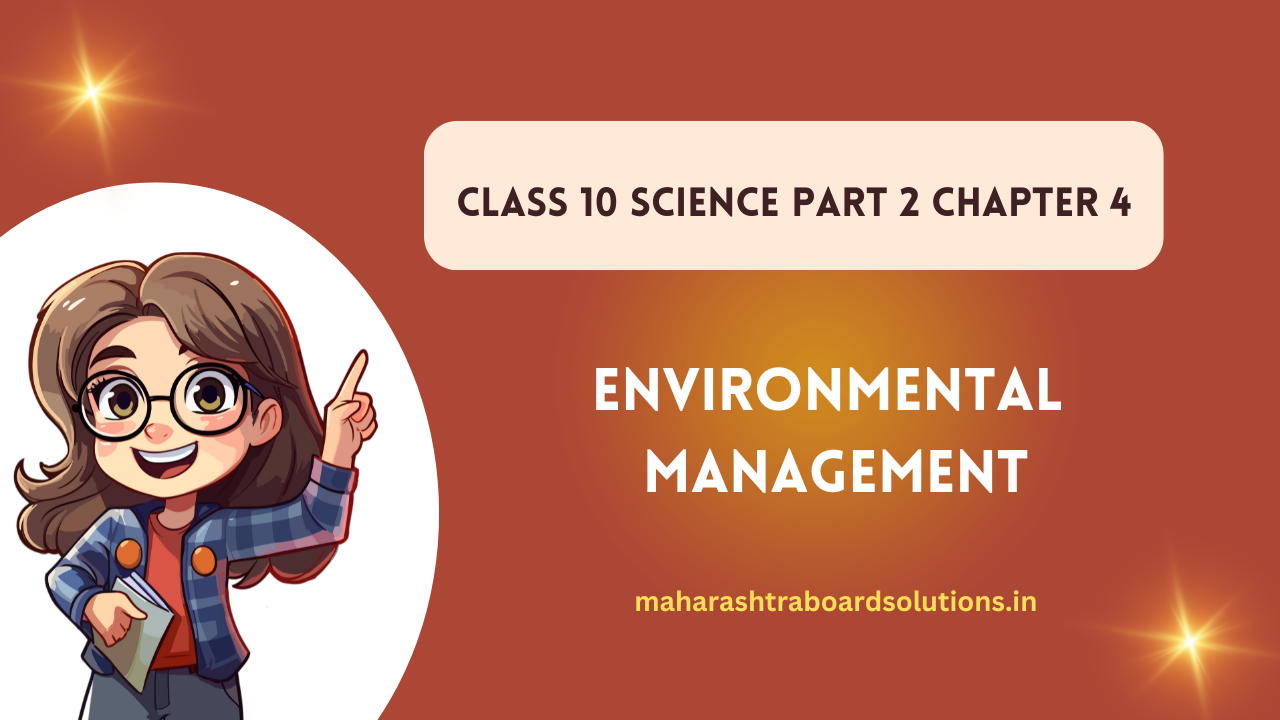Balbharti Maharashtra State Board Class 10 Science Solutions Part 2 Chapter 4 Environmental management Notes, Textbook Exercise Important Questions and Answers.
Std 10 Science Part 2 Chapter 3 Environmental management Question Answer Maharashtra Board
Class 10 Science Part 2 Chapter 3 Environmental managementQuestion Answer Maharashtra Board
Question 1.
Reorganize the following food chain. Describe the ecosystem to which it belongs.
Grasshopper – Snake – Paddy field – Eagle – Frog.
Answer:
- Correct food chain: Paddy field → Grasshopper → Frog → Snake → Eagle.
- Such food chain is seen in the terrestrial ecosystem. There are many biotic factors in the terrestrial ecosystem, such as insects, birds, mammals etc.
- The above example mentions about paddy field, so it must be in vicinity of coastal lands. There is water logging in the paddy fields. Therefore, it offers a habitat to the frogs.
- In the above example, paddy fields are producers in the ecosystem. The primary consumer is grasshopper. Secondary consumer is frog, tertiary consumer is snake and the apex consumer is eagle. On every trophic level the bacteria, fungi and some scavenging worms can act as the decomposers.
- In this ecosystem. the solar energy is transferred from the paddy crops to eagle in a step wise food
chain.
![]()
Question 2.
Explain the statement – ‘We have got this Earth planet on lease from our future generations and not as an ancestral property from our ancestors.’
Answer:
- The earth was inhabited by older generations before us. We have replaced them.
- But during their life time, they have created hazardous impact on the earth. The industrialization, the quest for more and more natural resources, wars fought, the construction activities such as dams, roads and bridges, extensive deforestation, etc. were their thoughtless activities.
- All these activities were for development of mankind. But most of them have destroyed the delicate balance between the producers and different levels of consumers.
- Due to ever increasing population of human beings there is shortage of food, clothing and shelter. To procure these basic needs, we have exploited many natural resources causing destruction of the earth’s natural ecosystem.
- Now it is our turn to protect the earth as on the same planet the next generations have to survive. We have to hand over the ecosystems of the earth which are in perfect balance to the new generations.
- The future generations need a good quality of air, water and land along with all other living organisms.
- Due to problems like climate change, global warming, pollution, droughts, etc. the environment is impacted, thus in order to keep sustainability of earth, we have to remember that the earth has not been obtained only as ancestral property but we have to save it for future generations.
Question 3.
Write short notes.
a. Environmental conservation.
Answer:
Due to natural and man-made causes, there are many environmental problems on the earth. These problems affect the existence of various living organisms. In order to save these organisms and maintain the environmental balance, there is need for environmental conservation. If this is not done then there will not be any quality of life for the resident humans. For environmental conservation, the Government has formulated acts and rules. UN has established UNEP for the conservation programs.
The people’s participation in the conservation movement is essential. From school age, the environmental values are inculcated in the young minds. Conservation of environment is the social responsibility of everyone. Judicial use of natural resources conservation also way of environmental conservation.
b. Chipko Movement of Bishnoi.
Answer:
Chipko Movement of Bishnoi or Bishnoi Andolan:
Khejarli or Khejadli is a village in Rajasthan, where Bishnoi community is located. The name of the town is derived from Khejri trees.
The first event of Chipko Movement took place in Khejadli village in 1730 AD. In this village 363 Bishnois, led by Amrita Devi sacrificed their lives for protecting the trees of Khejri trees, which trees are considered as sacred by Bishnoi.
Amrita Devi said, “if a tree is saved even at the cost of one’s head, it’s worth it”. She was killed with the axes that were brought to chop off the trees. The three young daughters Asu, Ratna and Bhagubai also sacrificed their lives for trees.
83 Bishnoi villages came together and villagers sacrificed their lives after hearing about Amrita Devi’s sacrifice. Three hundred and sixty-three Bishnois were killed as they opposed the king. After realizing the mistake, the king ordered stoppage of the felling of trees. Honouring the courage of the Bishnoi community, the ruler of Jodhpur, Maharaja Abhay Singh, apologized. He issued a royal decree to protect trees and wild life.
Chipko movement of 20th century in Uttar Pradesh also followed the same pattern of embracing the trees and saving them from cutting.
c. Biodiversity.
Answer:
Biodiversity means the diverse life forms that inhabit any area. Biodiversity is seen due to variety of life forms and different ecosystems that lodge these organisms. In nature there is biodiversity on the three different levels, viz. genetic diversity, species diversity and ecosystem diversity. This means that there is diversity in the individuals belonging to the same specips due to genetic reasons, there is diversity among the different species of organisms and there is also a diversity in the ecosystems that are present in any region.
Due to development of mankind, the biodiversity is threatened. There are special efforts taken to restore the lost and threatened biodiversity. Some of these are establishing sanctuaries, National Parks, biodiversity hotspots and reserves etc. Certain endangered species are protected by carrying out conservation projects.
d. Sacred Groves.
Answer:
Sacred grove is the green patch of the forest which is conserved by local people in the name of God. It does not belong to forest department. It is like a sanctuary that is conserved by the common people and tribals in the area. It is rich in the biodiversity.
It is conserved as there is a faith that God or deity reside in the sacred grove. Hence in local language, they are known as Deorai. Due to this reason, people do not fell the trees. Also hunting of any wild life is not done here. More than 13000 sacred groves have been reported in India. Most of these are in Western Ghats in Maharashtra, Karnataka and Kerala. Also, in remaining parts of India sacred groves are reported. Role of sacred grove is tremendous in conserving the biodiversity.
e. Disaster and its management.
Answer:
- To save human life from disasters. To help them for moving away from the place of disasters by rapid action.
- To supply essential commodities to the affected people. This helps to reduce the gravity of disaster. People are given grains, water and clothes and other basic necessities under this objective.
- To bring back the conditions of affected people to normalcy.
- To rehabilitate the affected and displaced victims.
- To think and execute the protective measures in order to develop capability to face the disasters in
future.
Question 4.
How will you justify that overcoming the pollution is a powerful way of environmental management?
(OR)
“Solving the problem of pollution is an effective way of environmental management.” Justify the statement.
Answer:
1. Pollution is created only due to human activities. Air, water, soil, noise, radiation, thermal, light, plastic are different types of pollution.
2. All types of pollution affect environment and particularly threatening the survival of living organisms.
3. Pollution must be controlled in order to have good quality of the environment. E.g. When plastic is thrown anywhere, it causes pollution of the land, it clogs the rain water drains, it affects feeding of the animals. Plastic pollution can be completely stopped by us through proper management of plastic waste. By recycling or reusing, we can overcome the plastic pollution. This would be a powerful way of environmental management.
4. Similarly, when we reduce pollution of different types, we automatically help to regain the environmental health.
Question 5.
Which projects will you run in relation to environmental conservatioh? How?
(OR)
Write six strategies implemented by you for conservation of the environment.
Answer:
Initially, assessment of the environmental problems will be done. The nature and severity of these problems will be understood by detailed study of the same. Then the projects can be undertaken to combat these problems.
1. Tree plantation is one such easier project that can be undertaken to conserve environment. The further nurturing of the tree will also be our responsibility. While selecting the tree, the local and sturdy varieties will be selected. Such trees can survive in polluted environment too and even under the pressure of urbanization.
2. Solid waste management is another very important project that should be undertaken by every society, colony or school. Segregation of waste into dry and wet types and then its proper disposal will be taught to all the people in the neighbouring area.
3. To ban the plastic and make people aware about harmful effects of plastic is another very significant project.
4. Fossil fuels are non-renewable and polluting. Therefore, their use should be reduced as far as possible. Therefore, using bicycle, or walking down for shorter distances or using public transport systems are the better alternatives. The awareness drive about these facts will be taken up as a project.
5. To take care of stray animals, provide shelter, feeding endangered birds like sparrows and allowing them to survive with our support is also one of the essential act to conserve other species.
6. Attempts will be made for bringing awareness among minds of everyone. Such small acts can bring about major shift in the attitude of the people. This will certainly help in the environmental conservation.
![]()
Question 6.
Answer the following:
a. Write the factors affecting environment.
Answer:
- The biotic and abiotic- factors affect the environment. Among abiotic factors, the physical and chemical factors can alter the conditions of the environment.
- Abiotic factors are either natural or man-made.
- The various interrelationships between different living organisms can also affect environment.
- The natural disasters such as earthquake, forest fires, cyclones, cloud bursting, drought, etc. change the environment.
- The human activities such as deforestation, urbanisation, constructions etc. cause permanent damage to the ecosystems. Due to man-made impact, there can be large scale changes in the environment.
b. Human beings have important place in environment.
Answer:
- Man came last on the earth during evolution of animals. But due to his intelligence, imagination, critical thinking and memory, he made progress in all fields.
- By virtue of these qualities he became the supreme.
- All the natural resources on the earth were very rapidly exploited by man.
- Under the pretext of technology and. development he made degradation of almost all¬natural ecosystems.
- He never obeys the rules of nature.
- Phenomena like pollution, urbanization, industrialization and deforestation are exclusively his creations.
- Hunting and poaching other animals were his contribution to the extinction of many other animals.
- Except man no other organism on the earth can change the ecosystems in such a drastic way. Therefore, it is rightly said that human beings have important place in environment.
c. Write the types and examples of biodiversity.
Answer:
Biodiversity is documented on the following three levels, viz. genetic diversity, species diversity and ecosystem diversity.
1. Genetic Diversity: Diversity seen among the organisms of same species due to genetic differences is called genetic diversity. E.g. The individual human beings are different from each other. No two animals or plants are exactly alike.
2. Species Diversity: The difference between the different species is the species diversity, e.g. All the species of plants, animals and microbes which are seen in any natural environment.
3. Ecosystem Diversity: In one region there may be different ecosystems, such diversity in the ecosystems is called ecosystem diversity. Ecosystems are natural or artificial. Every region shows different types of ecosystems such as aquatic, terrestrial, desert or forest ecosystems. Each ecosystem has its own habitats with resident flora and fauna.
d. How the biodiversity can be conserved?
Answer:
Biodiversity can be conserved by the following ways:
- Protection of the rare species of plants and animals.
- Creating habitats for the animals and plants by establishing National Parkland Sanctuaries.
- Declaration of bioreserves, the areas which are protected through conservation.
- Conservation projects for protecting special species.
- Conservation of all flora and fauna.
- Strict observance of the acts and rules.
- Use of traditional knowledge and maintaining record of traditional knowledge.
e. What do we learn from the story of Jadav Molai Payeng? (Board’s Model Activity Sheet)
Answer:
Jadav Molai Payeng is a common man who was just a simple forest worker. But he has conscience about plants and tree plantations. He single-handedly planted thousands of trees. He converted a barren patch of land into forest which is spread over 1360 acres. For these plantations he continuously worked.
He has shown that a single determined person, can establish a new forest! We understand the values of
hard work, sincerity and devotion to the nature through the story of Jadav Molai Payeng. Even a common man can contribute a lot for the conservation and protection of the environment by learning the story of Payeng.
f. Write the names of biodiversity hot spots.
Answer:
- In entire world, 34 highly sensitive biodiversity spots are reported.
- These hotspots occupied 15.7% area of the Earth.
- However, currently about 86% of the sensitive areas are already destroyed.
- Now about 2.3% area of the Earth still has such sensitive biodiversity spots.
- There are 1,50,000 plant species which are about 50% of the species in the world.
- In India, out of 135 species of animals, 85 species are found in the jungles of eastern region.
- There are about 1,500 endemic plant species in Western Ghats.
- About 50,000 plants species out of the total plants in the world are said to be endemic.
g. Which are the reasons for endangering the many species of plants and animals? How can we save those diversity?
Answer:
- The animals and plants species are endangered majorly due to man-made causes.
- Some natural disasters like earthquakes, climate change, forest fires, drought and cyclones also affect the living organisms due to lack of food and water.
- In man-made causes, hunting and poaching are the main reasons.
- Also animal-human conflicts occur due to invasion of human settlements into the habitats of wild animals.
- Construction of dams, roads, and colonies destroy the habitats of wild life.
- Industrialization, urbanization and population explosion of humans are putting severe pressure on all the existing biodiversity.
- In order to save and protect the biodiversity, many scientists and naturalists come together. A stretch of land is protected by declaring it as the sanctuary or a national park by the Government. Even the locals can protect it as a sacred grove.
- Various acts and rules have been formulated to protect the organisms. The violators of such rules are punished accordingly.
Question 7.
What are the meanings of the following symbols? Write your role accordingly. (July ’19; Board’s Model Activity Sheet)
(OR)
What do these symbols indicate? Explain your opinion about those symbols.
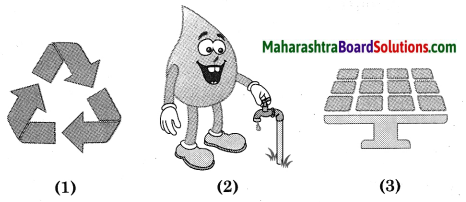
Answer:
1. The first symbol is for giving the message, “Reduce, reuse and recycle”. This is important mantra for the utilization of natural resources.
The second symbol gives the message about ‘Save water’.
The third symbol advocates the use of solar energy.
2. These symbols inculcate the importance of being eco-friendly. The first symbol is essential to maintain the natural resources by reusing and recycling them. As far as possible, one should reduce the excessive use of resources by preventing consumerism.
3. Water problems persist in many major cities and villages. In villages it results in drought like conditions. It also reflects into loss of agricultural produce. Therefore, the message about saving water or to make judicious use of water should be spread far and wide.
4. The solar energy is the renewable energy option which is very easily available in country like India. By using solar energy, we can replace the polluting and exhaustible fuels. Thereby, pollution will also be reduced.
Due to such symbols, important messages about environment conservation reach, us and we can change ourselves into more eeofriendly persons.
Project: (Do it your self)
Project 1.
Make a presentation on pollution of Gangci and Yamuna Rivers and effects of air pollution on Taimuhal.
![]()
Can you recall? (Text Book Page No. 36)
Question 1.
What is ecosystem? Which are its different components?
Answer:
In any environment, there are biotic and abiotic components. There are interactions among these components. All such interactions make an ecosystem.
The different components in the ecosystem are as follows:
Abiotic components : Air, water, soil, sunlight, temperature, humidity, etc.
Biotic components: All the types of living organisms, like bacteria, fungi, plants and animals.
Question 2.
Which are the types of consumers? What are the criteria for their classification?
Answer:
Primary consumers, secondary consumers, tertiary consumers or apex consumers are the different types of consumers. These types are according to the trophic level to which they belong.
Question 3.
What may be the relationship between lake and birds on tree?
Answer:
The birds on the tree depend on the aquatic organisms in the lake for their feeding. Birds stay on the trees which are in the vicinity of the lake, so that it is easier for them to capture fishes, frogs, etc. They must also be using the same lake water for drinking.
Question 4.
What is difference between food chain and food web?
Answer:
In every ecosystem, there are always interactions between producers, consumers and decomposers. This sequence of feeding interactions is called food chain. In every food chain there are links between four to five trophic levels constituting the producers, primary consumers, secondary consumers, tertiary consumers, etc. The links of food chain are in linear sequence. But food web is a complex network of many small food chains. In fact, food web is the collection of many small food chains. Thus, when many food chains are interwoven, they form food web.
Think and Answer! (Text Book Page No. 36)
Question 1.
Write the name and category of each of the component shown in picture.
Answer:
By utilizing the solar energy, the green plants perform photosynthesis. Thus, they are producers of the food chain. This food is consumed by the grasshopper. Thus, it is primary consumer. Frog is secondary consumer as its diet consists of insects like grasshopper. Snake is tertiary consumer as it feeds on frogs, while the hawk is apex consumer as it can kill the snake and feed on it. Last picture in the food chain is of fungi which are acting as decomposers. Few bacteria are shown in the picture, act on all the levels and bring about decomposition.
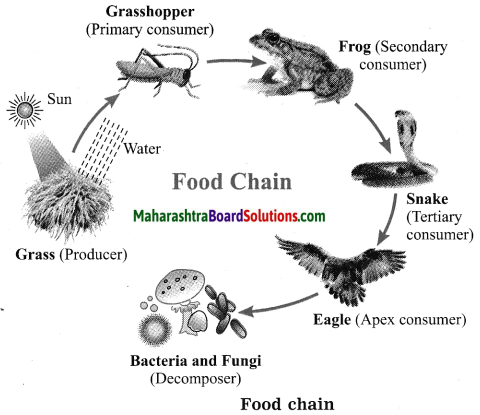
![]()
Question 2.
What is necessary to convert this picture into food web? Why?
Answer:
If this food chain has to be converted into a food web, there should be interactions between the different components. Any living organism can be prey to different predators. Moreover, a predator can also be a prey for other. Frog eats different insects. The same frog can be either eaten by snake or by hawk.
Use your brain power. (Text Book Page No. 40)
Question 1.
Why is it said that pollution control is important?
Answer:
The quantity of pollutants and severity of their effects on the ecosystem have to be taken into consideration constantly. The different methods of pollution control have to be used for checking the hazardous effects of pollution on the living organisms. Especially the impact of pollution on health of human beings is assessed from time to time.
The young children and senior citizens are affected to greater extent by the pollution. If the air and water required for the survival of the people is affected, then exercising the pollution control is to be done immediately. Thus, it is said that pollution control is important.
Enlist and discuss (Text Book Page No. 43)
Question 1.
Find the meaning of given symbols in relation to environment conservation. Make a list of other such symbols.
A. 
Answer:
This symbol tells us to keep our wastes carefully. The garbage should not be strewn anywhere. But it should be properly managed. Waste if managed properly can be a wealth.
B. 
Answer:
This symbol tells us to save electricity. If electricity is carefully used, we can save our natural resources. This message is given through this picture.
C. 
Answer:
Use of bicycle means use of green energy. By riding on a bicycle we save on fuel and use our own muscular energy. It is the best eeofriendly, non polluting vehicle.
Observe and fill the information: (Text Book Page No. 8)
Question 1.
Observe the environment around you. Complete the following flow chart.
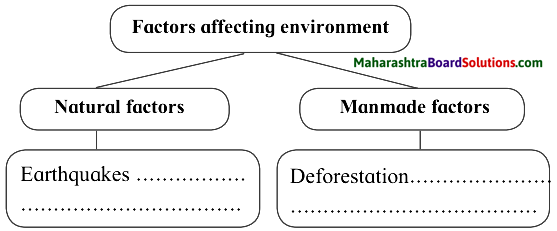
Answer:

![]()
Complete the Chart: (Text Book Page No. 39)
Question 1.
We have studied the air pollution, water pollution and soil pollution in detail in earlier classes. Based on that, complete the following chart.
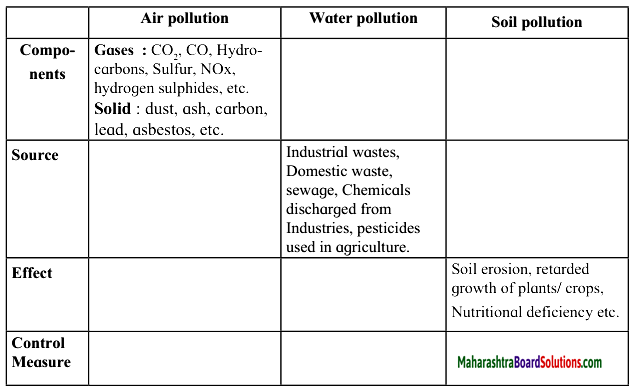
Answer:
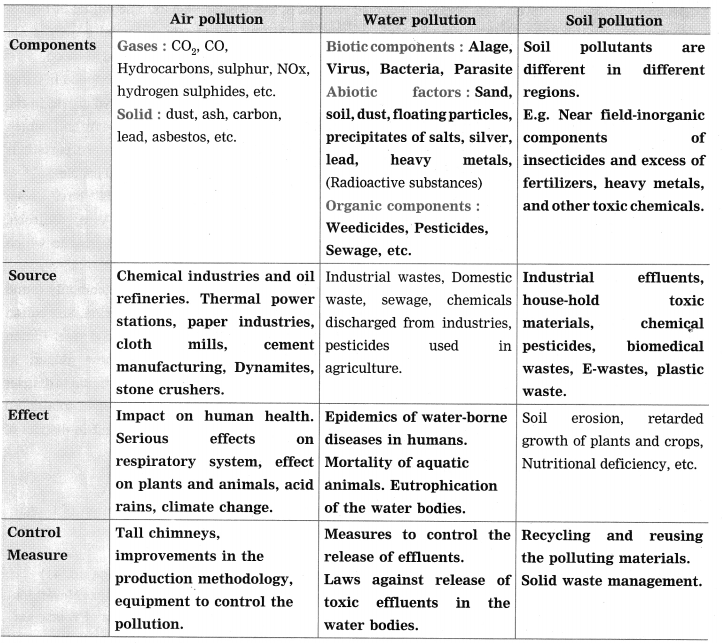
Complete the Chart: (Text Book Page No. 40)
Question 1.
Now a day, we are observing the environmental degradation everywhere. Complete the flow chart given besides with the help of environment.
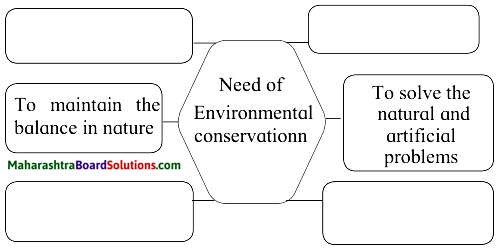
Answer:
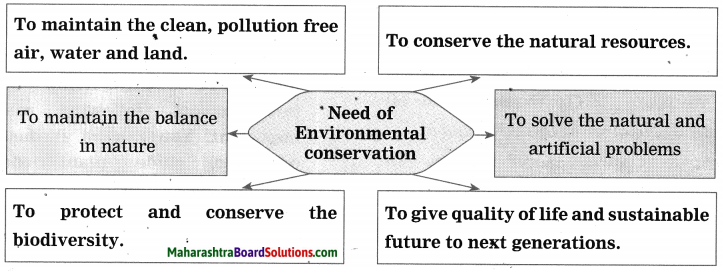
(Text Book Page No. 43)
Question 1.
Where are such sacred groves in Maharashtra? Make a list and visit with your teachers.
Answer:
Sacred groves: Sacred groves form an important landscape feature in the deforested hill ranges of the Western Ghats. The felling of timber and the killing of animals in sacred groves is not allowed by the locals. It is considered as taboo.
In Maharashtra, sacred groves are found in tribal as well as non-tribal areas. The sacred groves in the western part are called Devrai or Devrahati, which means the abode of the gods. In eastern parts it is called Devegudi by the madiya tribal people.
In Maharashtra 2820 Devrais have been documented. Maruti, Vaghoba, Vira, Bhiroba, Khandoba and Shirkai are some deities to which sacred groves are dedicated.
In the sacred groves, the most commonly found plant species are Portia tree, Casuarina, Silk cotton tree, Indian laurel, Indian Elm, Bead tree, Indian butter tree, Turmeric and Japanese ginger. In Maharashtra, sacred groves are maximum in district of Sindhudurg, (More than 1500 out of total 2820) followed by Ratnagiri, then Pune and in district of Satara.
Choose the correct alternative and write that alphabet against the sub-question number:
Question 1.
Paddy fields are frequently attacked by
(a) goats
(b) birds
(c) grasshoppers
(d) monkeys
Answer:
(c) grasshoppers
Question 2.
Basic functional unit to study the ecology is termed as ……………
(a) environment
(b) niche
(c) ecosystem
(d) food chain
Answer:
(c) ecosystem
Question 3.
As per ……….. trading of rare animals has been completely banned.
(a) clause 48A
(b) clause 49B
(c) clause 49A
(d) all the above
Answer:
(c) clause 49A
Question 4.
(4) The jungle in Kokilamukh of Jorhat district of Assam is well known as ………….
(a) Molai jungle
(b) Rhino jungle
(c) Rhino forest
(d) Payang jungle
Answer:
(a) Molai jungle
Question 5.
Maintaining record of ………. knowledge is very necessary.
(a) modern
(b) mythical
(c) vedic
(d) traditional
Answer:
(d) traditional
Question 6.
………… is world’s largest organization engaged in environmental activities.
(a) Greenpeace
(b) Hariyali
(c) B. N. H. S.
(d) I. I. T.
Answer:
(a) Greenpeace
Question 7.
……….. sanctuary of West Bengal is reserved for tigers.
(a) Gir
(b) Sunderban
(c) Molai
(d) Corbett
Answer:
(b) Sunderban
![]()
Question 8.
World Biodiversity Day is celebrated on ……… every year.
(a) 22nd April
(b) 5th June
(c) 16th September
(d) 22nd May
Answer:
(d) 22nd May
Question 9.
Out of the total plant species in the entire world, 50,000 are ……………
(a) extinct
(b) endangered
(c) endemic
(d) rare
Answer:
(c) endemic
Question 10.
Giant squirrel is an ………… species.
(a) indeterminate
(b) rare
(c) endemic
(d) endangered
Answer:
(a) indeterminate
Question 11.
In a food chain, autotrophic plants are present at the ……….. level. (March 2019)
(a) tertiary nutrition
(b) secondary nutrition
(c) producer
(d) apex
Answer:
(c) producer
Question 12.
……….. from Manas sanctuary in Assam is under threat. (Board’s Model Activity Sheet)
(a) one horned rhino
(b) Lion
(c) Musk deer
(d) Giant squirrel/Shekru
Answer:
(a) one horned rhino
Write whether the following statements are true or false, giving suitable explanation for the same:
Question 1.
Only abiotic factors play very important role in the ecosystem.
Answer:
False. (Both abiotic and biotic factors play very important role in the ecosystem. Only abiotic factors will not decide the working of an ecosystem.)
Question 2.
Paddy fields are frequently attacked by frogs.
Answer:
False. (Paddy fields are frequently attacked by grasshoppers. Frogs feed on grasshoppers and control the population of these insects that cause destruction of the crops.)
Question 3.
Environmental pollution is necessary and acceptable change in the surrounding environment.
Answer:
False. (Environmental pollution is never acceptable. It is always harmful to the entire ecosystem and thus never necessary.)
Question 4.
X-rays and radiations from atomic energy plants are natural radiations.
Answer:
False. (X-rays are not present in natural radiations. Infra-red and ultra-violet rays are present in natural radiations.)
Question 5.
The person breaching the Environmental Conservation Act is entitled for either one year imprisonment or fine up to ₹ 5 lakh.
Answer:
False. (The person breaching the Environmental conservation Act is fined upto ₹ 1 lakh. He is also entitled to imprisonment for five years.)
Question 6.
Many people come together to establish arnew forest but a single person, if determined can destroy the entire forest!
Answer:
False. (When anything constructive has to be done even a single man can start such action. In case of ‘Molai jungle’, this statement holds true. But when destructive actions are done, many people come together and cause damage.)
![]()
Question 7.
There are clusters of thick forests only in Western Ghats of India.
Answer:
False. (Entire India is rich in biodiversity. Just not in Western Ghats but in entire India one can observe the clusters of thick forests and this is mainly due to suitable tropical climate.)
Question 8.
86 highly sensitive biodiversity spots are reported all over the world.
Answer:
False. (As per the latest information and available data, there are 34 highly sensitive biodiversity spots.)
Question 9.
Flow of nutrients in an ecosystem is unidirectional.
Answer:
False. (Flow of energy in an ecosystem is unidirectional. Flow of nutrients is cyclic.)
Match the columns:
Question 1.
| Column I | Column II |
| (1) Physical, chemical and biological factors together form | (a) Biodiversity |
| (2) The science of interactions between biotic and abiotic factors | (b) Ecosystem |
| (c) Ecology | |
| (d) Environment |
Answer:
(1) Physical, chemical and biological factors together form – Environment.
(2) The science of interactions between biotic and abiotic factors – Ecology.
Question 2.
| Column I | Column II |
| (1) Basic functional unit in the environment | (a) Biodiversity |
| (2) Different types of living organisms | (b) Ecosystem |
| (c) Ecology | |
| (d) Environment |
Answer:
(1) Basic functional unit in the environment – Ecosystem.
(2) Different types of living organisms – Biodiversity.
Question 3.
| Rules/Act | Year |
| (1) Sound Pollution (Control and Prevention) Rule | (a) 1980 |
| (2) Biomedical Waste (Management and Handling) Rule | (b) 2011 |
| (c) 1998 | |
| (d) 2000 |
Answer:
(1) Sound Pollution (Control and Prevention) Rule – 2000.
(2) Biomedical Waste (Management and Handling) Rule – 1998.
Question 4.
| Rules/Act | Year |
| (1) Forest Conservation Act | (a) 1980 |
| (2) Environmental Conservation Act | (b) 1986 |
| (c) 2011 | |
| (d) 2000 |
Answer:
(1) Forest Conservation Act – 1980.
(2) Environmental Conservation Act – 1986.
Question 5.
| Species | Examples |
| (1) Endangered | (a) Red panda, Musk deer. |
| (2) Rare | (b) Tiger, Lion. |
| (c) Lion tailed monkey, lesser florican. | |
| (d) Monkey, squirrel |
Answer:
(1) Endangered Species – Lion tailed monkey, lesser florican.
(2) Rare Species – Red panda, Musk deer.
Question 6.
| Species | Examples |
| (1) Vulnerable | (a) Giant squirrel (Shekhru) |
| (2) Indeterminate | (b) Red panda, Musk deer |
| (c) Tiger, Lion | |
| (d) Lesser florican, sparrow |
Answer:
(1) Vulnerable Species – Tiger, Lion.
(2) Indeterminate Species – Giant squirrel (Shekhru).
Find the odd one out:
Question 1.
Ash, Carbon dioxide, Lead, Asbestos
Answer:
Carbon dioxide. (All others are solid particulate pollutants.)
Question 2.
Manas sanctuary, Sunderbans sanctuary, The Western Ghats, Tadoba National Park
Answer:
Tadoba National Park. (All others are endangered heritage places of India.)
Question 3.
Lion tailed monkey, White rats, Musk deer, Tiger
Answer:
White rats. (All others are species that are threatened.)
![]()
Question 4.
Conservation, Regulation, Pollution, Prohibition
Answer:
Pollution. (All others are ways of environmental protection.)
Question 5.
IPCC, UNEP, IUCN, BNHS
Answer:
BNHS. (All others are international organizations. BNHS is Bombay Natural History Society.)
Find the correlation:
Question 1.
Rare species : Musk deer : : ………… : Lesser florican.
Answer:
Endangered species
Question 2.
Red panda : Rare species : : Giant Squirrel : …………
Answer:
Indeterminate species
Question 3.
Nitrogen, Oxygen : Gaseous cycle : : Soil and Rocks : …………
Answer:
Sedimentary cycle
Question 4.
Manas : One horned Rhino : : Gir : ………..
Answer:
Asiatic lion
Question 5.
Mumbai : Bombay Natural History Society : : TehriGarhwal : ………….
Answer:
Chipko centre.
Answer the following questions in detail:
Question 1.
Answer the following questions:
If frog population in paddy field declines all of a sudden,
(a) What will be the effect on paddy crop?
Answer:
If the population of frog declines, then there will be rise in the population of grasshoppers. The paddy fields will hence be infested with insect pests.
(b) Number of which consumers will decline and which will increase?
Answer:
The food chain if altered, results in imbalance in the ecosystem. ‘Paddy → Grasshoppers → Frog → Snake’, this food chain is natural. When by any reason there is dec1ine in the number of frogs, thus secondary consumer will also decline. Due to this decline, snake which is at tertiary consumer level will also decline. Theprimary consumers i.e. grasshoppers will increase as there is now no check on their population. Due to increase in their population the paddy production will be reduced. Due to reduced number of snakes, rats and other rodents from neighbouring areas would also rise, which are also secondary consumers.
(c) Name the Indian states where paddy is cultivated on a large scale.
Answer:
West Bengal, Uttar Pradesh, Haryana, Punjab, Tamil Nadu, Andhra Pradesh, Bihar, Chhattisgarh, Odisha, Assam and Maharashtra.
Question 2.
What is radioactive pollution? What are its effects?
Answer:
(1) The radiations emitted either through the natural sources or through man-made sources cause radioactive pollution.
(2) The natural radiations is in the form of ultra violet and infrared radiations.
(3) Artificial or man-made radiations are X-rays and radiations from atomic energy plants.
(4) All radiations are highly hazardous for the living organisms. The impact of radiation is also for a very long time.
(5) It has brought about major accidental mishaps at Chernobyl, Windscale, qpd Three Miles Island. These disasters have affected thousands of people.
(6) Some other effects of radiations are as follows – (i) Due to higher radiations of X-rays, cancerous ulceration occurs, (ii) Radiations destroy the body tissues, (iii) Radiations cause mutations and thus genetic changes occur, (iv) There is adverse effect on the vision.
Question 3.
Give one word for “The forest conserved in the name of God.” (Board’s Model Activity Sheet)
Answer:
Deorai.
Give scientific reasons:
Question 1.
Certain scavenging caterpillars, termites and insects found in the dung are important.
Answer:
- Scavenging caterpillars and insects are decomposers. They seem to be Worthless due to filthy surrounding in which they thrive.
- But they carry out most important task of decomposition of complex organic substances into simple inorganic elements.
- This recycling is possible only due to decomposers.
- If they are not present, there will be huge accumulation of garbage. Therefore, these living organisms are important.
Question 2.
Destroying trees is to destroy everything.
Answer:
- When a single huge tree is felled many living organisms which are dependent on it, are exterminated.
- Many insects, fungi, birds, etc. lose their habitat.
- Trees take up carbon dioxide from the atmosphere and release oxygen. These natural cycles are also hindered due to loss of trees.
- Due to trees there is shade, cooler atmosphere and increase in the rainfall. When such trees are destroyed all the components in the ecosystem are destroyed too.
Question 3.
There is no definite information about indeterminate species.
Answer:
- Indeterminate species do not have substantial information about them.
- The organisms belonging to such species appear to be endangered due to their some behavioural habits.
- They are shy and do not come in open so that they can be observed keenly.
- For example, animals like Giant squirrel also do not provide such information.
Question 4.
Tigers from Sunderbans and Rhinos from Manas are under threat.
Answer:
- Manas is in the area-of Assam where there are many dams and Indiscriminate use of water.
- This area is also flood affected. Therefore, rhinos are under threat.
- In Sunderbans, there are also problems such as deforestation, dams, excessive fishing, and dug out trenches.
- All of these cause dangers to the tiger population.
Question 5.
There are clusters of thick forests in the Western Ghats of India.
Answer:
- There are many sacred groves in the region of Western Ghats of India.
- These forests are not conserved by Government Forest Departments but are cared for by the local people, in the name of God.
- Due to such faith in the people, the forests are conserved like sanctuaries.
- Such many clusters are in Western Ghats of Maharashtra.
![]()
Question 6.
We can see biodiversity on three levels.
Answer:
- There is biodiversity in the living organisms belonging to the same genus.
- This diversity is due to different heredity pattern. This is called genetic biodiversity.
- The organisms occupying the same area and belonging to the same species also show diversity due to different species. This is species biodiversity.
- The organisms occupying different ecosystems also show differences, which is called ecosystem biodiversity. Therefore, we observe biodiversity on three different levels.
Questions based on diagrams:
Question 1.
What is shown in the picture? Write name and trophic level of each component.
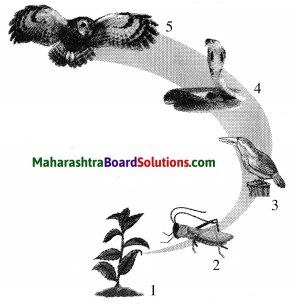
Answer:
In this picture, food chain having rive trophic levels is shown.
(1) Trophic level 1 = Producers : Green plant.
(2) Trophic level 2 = Primary consumer (Herbivore): Grasshopper.
(3) Trophic level 3 = Secondary consumer (Carnivore): Bird.
(4) Trophic level 4 = Tertiary consumer (Carnivore) : Snake.
(5) Trophic level 5 = Top or Apex consumer (Carnivore) : Owl.
Question 2.
Explain the meaning of following symbols A and B and C.
A.

Answer:
The symbol show types of green energy such as solar energy and wind energy. It also expresses that people
should use such sources of energy for their use.
B.

Answer:
This symbol is giving the message “Save water”. Sustainable use of water is necessary for our future.
C.

answer:
The symbols of WWF and BNHS are shown here. BNHS stands for Bombay Natural History Society. This institute works for the conservation and documentation of flora and fauna.
WWF means World Wild Life Fund. Also known as World Wide Life Fund. This International Institute is looking after the welfare of wildlife through different conservation projects. WWF symbol shows Panda while BNHS symbol has Giant Hornbill.
Question 3.
(a) Identify the following symbols and state their significance: (March 2019)
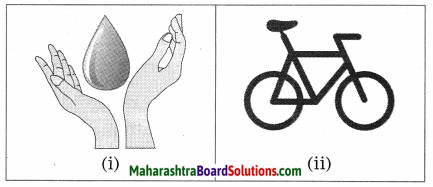
Answer:
(i) This symbol is giving the message “Save water”. Sustainable use of water is necessary for our future.
(ii) Use of bicycle means use of green energy. By riding on a bicycle we save on fuel and use our own muscular energy. It is the best ecofriendly, non polluting vehicle.
(b) How can biodiversity be conserved?
Answer:
Biodiversity can be conserved by the following ways:
- Protection of the rare species of plants and animals.
- Creating habitats for the animals and plants by establishing National Park and Sanctuaries.
- Declaration of bio reserves, the areas which are protected through conservation.
- Conservation projects for protecting special species.
- Conservation of all flora and fauna.
- Strict observance of the acts and rules.
- Use of traditional knowledge and maintaining record of traditional knowledge.
Activity based questions:
Question 1.
Questions based on the charts.
Complete the flow chart: (July 2019)
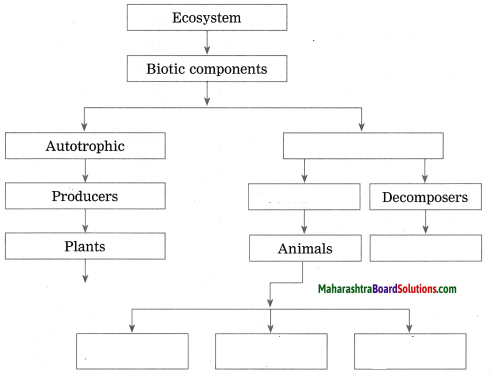
Answer:
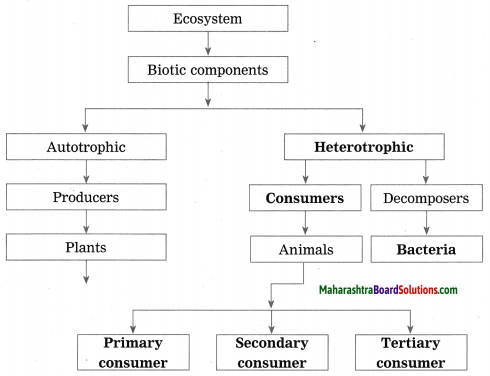
![]()
Question 2.
Collect more information about locations of these hotspots present in the world. (Textbook page no. 44)
Answer:
Students should collect this information.
Question 3.
Where are such sacred groves in Maharashtra? Make a list and visit with your teachers. (Textbook page no. 43)
Answer:
Sacred groves: Sacred groves form an important landscape feature in the deforested hill ranges of the Western Ghats. The felling of timber and the killing of animals in sacred groves is not allowed by the locals. It is considered as taboo.
In Maharashtra, sacred groves are found in tribal as well as non-tribal areas. The sacred groves in the western part are called Devrai or Devrahati, which means the abode of the gods. In eastern parts it is called Devegudi by the madiya tribal people.
In Maharashtra 2820 Devrais have been documented. Maruti, Vaghoba, Vira, Bhiroba, Khandoba and Shirkai are some deities to which sacred groves are dedicated.
In the sacred groves, the most commonly found plant species are Portia tree, Casuarina, Silk cotton tree, Indian laurel, Indian Elm, Bead tree, Indian butter tree, Turmeric and Japanese ginger. In Maharashtra, sacred groves are maximum in district of Sindhudurg, (More than 1500 out of total 2820) followed by Ratnagiri, then Pune and in district of Satara.
![]()
Projects: (Do it your self)
Project 1.
Let’s Discuss: (Text Book Page No. 41)
Collect the information about Chipko Movement and discuss between two groups of your class about its importance in present situation.
Project 2.
Collect more information on the organization of Greenpeace. (Text Book Page No. 43)
Answer:
Students are expected to write this answer to this question.
Project 3.
There should be positive attitude of human being towards the environment for welfare of entire living world. For this purpose, following roles are important. You can be a conservator, organizer, guide, plant-friend, etc. Describe about the role you wish to perform and your plans for that role. (Text Book Page No. 42)
Project 4.
Survey the plants and animals in your area. Maintain a record about their characteristics. (Text Book Page No. 45)
Answer:
Students can conduct such surveys with the help of elders.
Project 5.
Internet is my friend! (Collect the information Textbook page no. 41)
(1) Sound Pollution (Control and Prevention) Rule, 2000.
(2) Biomedical Waste (Management and Handling) Rule, 1998.
(3) E-waste (Management and Handling) Rule, 2011.
10th Std Science Part 2 Questions And Answers:
- Heredity and Evolution Class 10 Questions And Answers
- Life Processes in Living Organisms Part – 1 Class 10 Questions And Answers
- Life Processes in Living Organisms Part – 2 Class 10 Questions And Answers
- Environmental management Class 10 Questions And Answers
- Towards Green Energy Class 10 Questions And Answers
- Animal Classification Class 10 Questions And Answers
- Introduction to Microbiology Class 10 Questions And Answers
- Cell Biology and Biotechnology Class 10 Questions And Answers
- Social health Class 10 Questions And Answers
- Disaster Management Class 10 Questions And Answers
